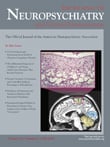Varenicline and Adult ADHD
To the Editor: Nicotine dependence is perpetuated by biobehavioral rewards generated as the result of nicotine’s interaction with the brain’s neurochemical systems. 1 Nicotine’s memory-enhancing reward is believed to result from its effects on specific nicotinic acetylcholine receptors. 2 Nicotine’s attentional, antidepressant, and antianxiety rewards are thought to be due to pathways between nicotinic acetylcholine receptors and noncholinergic neuronal subtypes that selectively traffic dopamine, norepinephrine, 5-hydroxytryptamine, and gamma-aminobutyric acid. 3
Varenicline is a new treatment for nicotine dependence and a member of the selective alpha4beta2 nicotinic acetylcholine receptor partial agonist class. 4 Central nicotinic acetylcholine receptors have been implicated in attention deficit hyperactivity disorder (ADHD), 5 and an alpha4beta2 antagonist counteracted nicotine-induced improvement in an animal model of ADHD. 6
The first case of adult ADHD that responded to the addition of varenicline is reported here.
Case Report
Ms. A, a 26-year-old white woman, was self-referred in 2007 for difficulties staying focused, staying on task, and with reading comprehension. She fulfilled DSM-IV-TR criteria for ADHD, but was against the initial recommendation to begin taking a prescription stimulant. The administration of the antidepressants bupropion (150 mg) and venlafaxine (up to 150 mg), each alone or in combination with valproic acid, was met with either side effects or undesirable results. The medicine selected was based on office sample availability at Ms. A’s request because of financial problems. A wealthier patient had previously donated a barely used varenicline prescription that she had abandoned due to nausea. Ms. A agreed to undergo a trial of varenicline taking 0.5 mg in the morning, after eating a low-acid breakfast, with an 8-oz glass of water. Her reading comprehension and ability to focus improved substantially after reaching 1 mg b.i.d. Her mild hyperactivity improved marginally. She complained of no side effects as she completed 6 weeks, including weekends, of the clinic’s subsidized varenicline treatment trial. Her problematic ADHD symptoms fully resurfaced about 2 days after she ran out of varenicline. Ms. A agreed to continue medicine trials using affordable antidepressant, dopamine agonist, or nicotine replacement generics.
Comment
Although this report does not rule out the placebo effect, and a therapeutic connection between varenicline and ADHD cannot be established with certainty, this case does suggest that the new selective alpha4beta2 nicotinic acetylcholine receptor partial agonist class of medicines is useful in the management of adult ADHD. In particular, the varenicline-ADHD interface warrants further investigation using larger groups of subjects, more sophisticated study designs, and a variety of memory deficits such as depression and mild cognitive impairment.
1 . Rosecrans JA: The biobehavioral effects of nicotine: interaction with brain neurochemical systems, in The Clinical Management of Nicotine Dependence. Edited by Cocores JA. New York, Springer-Verlag, 1991, pp 53–65Google Scholar
2 . Mansvelder HD, van Aerde KI, Couey JJ, et al: Nicotinic modulation of neuronal networks: from receptors to cognition. Psychopharmacology (Berl) 2006; 184:292–305Google Scholar
3 . Rosecrans JA, Krynock GM, Newlon PG, et al: Central mechanisms of drugs as discriminative stimuli: involvement of serotonin pathways, in Stimulus Properties: Ten Years of Progress. Edited by Colapaert FC, Rosecrans JA. Amsterdam, Elsevier/North-Holland Press, 1978, pp 83–98Google Scholar
4 . Lam S, Patel PN: Varenicline: a selective alpha4beta2 nicotinic acetylcholine receptor partial agonist approved for cessation. Cardiol Rev 2007; 15:154–161Google Scholar
5 . Potter AS, Newhouse PA, Bucci DJ: Central nicotinic cholinergic systems: a role in the cognitive dysfunction in attention-deficit/hyperactivity disorder? Behav Brain Res 2006; 175:201–211Google Scholar
6 . Ueno K, Togashi H, Matsumoto M: Alpha4beta2 nicotinic acetylcholine receptor activation ameliorates impairment of spontaneous alternation behavior in stroke-prone spontaneously hypertensive rats, an animal model of attention deficit hyperactivity disorder. J Pharmacol Exp Ther 2002; 302:95–100Google Scholar



